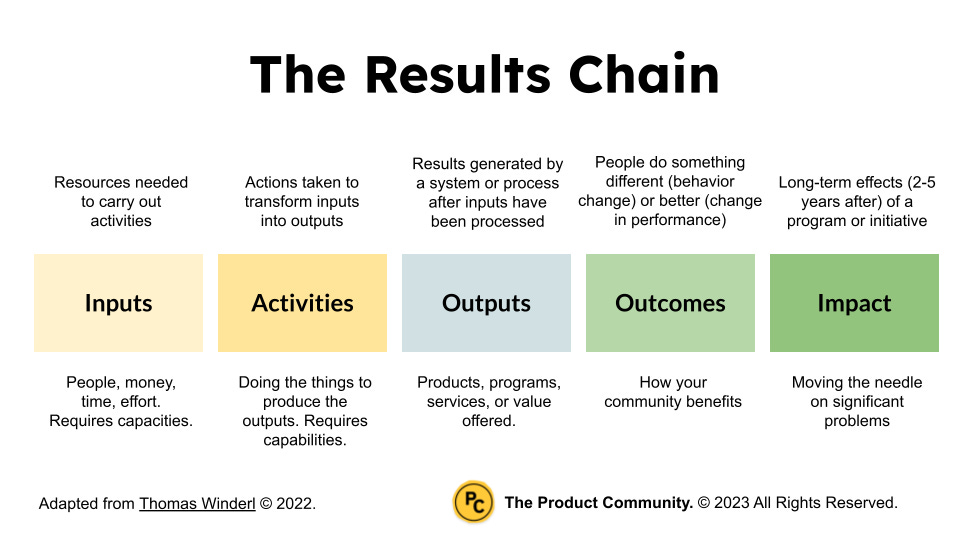Summary
In last week’s article (Measure What Matters) I covered metric basics and drew a distinction between key performance indicators or KPIs (a measure of management success) and objectives and key results or OKRs (a measure of strategic performance).
In this article, I cover two complementary topics related to performance metrics:
The results chain: how inputs and activities result in outputs, outcomes, and impact.
Examples of low-impact, medium-impact, and high-impact metrics.
In doing so, I continue to build a case for investing in and committing to a metrics program that gauges our progress toward meaningful, short-term goals that, over time, contributes to a more focused and ambitious shared future.
The concepts I present in this article can be applied to a single product or initiative (annual conference, strategic aim, course pathway, or membership), comparing performance across products or initiatives, or gauging the success of the entirety of a product portfolio.
The Product Community is a product development learning community designed specifically for associations.
The Results Chain
“Outcomes are changes in human behavior that drive business results.”
Josh Seiden
We use metrics to measure lots of things. This article is about intentionality, choice, and using metrics to balance the day-to-day operations with more strategic, long-term aspirations.
A results chain is a tool that shows how particular actions will lead to a desired result. As we move from left to right in the below diagram, a chain of successive events link inputs and activities with intended outputs, outcomes, and impacts.
Let’s build on this with some basic definitions.
An input is something that is put into a system or process. It can be data, information, materials, or resources that are used to achieve a specific goal. Activities bridge inputs and outputs by focusing our capabilities on efficient, prioritized actions.
An output is what is produced or generated by a system or process after inputs have been processed or transformed. They are completed tasks, large or small: programs, products, or services delivered to a customer, stakeholder, or user. Outputs are typically measurable and tangible.
An outcome is what our members want; it is our desired impact. Outcomes create focus and alignment and puts the member at the center of everything we do.
An outcome is how our community benefits. Outcomes are often less tangible than outputs and are typically measured in terms of changes in behavior, attitudes, knowledge, or change in performance.
In the context of an association, here are some examples of each:
Input. A membership application form that a new member fills out to join the association. This form provides input to the association's membership database, which is used to track membership data and communication preferences.
Output. A newsletter that the association sends out to its members every month. This newsletter is an output of the association's communication process and provides members with updates, news, and resources related to the association's mission and activities.
Outcome. A training program that we develop and deliver to improve skills or knowledge. The outcome of this program is the improved performance of members in their professional roles, which can lead to increased effectiveness and impact in their work.
For purposes of this article, we define impact as moving the needle on significant problems typically tied to an association’s mission, vision, and values. This is much, much harder than I’m making it sound. Often reaching these moonshot goals is beyond our control. Despite this, it’s critical we design for realistic, incremental movements towards the north star.
Outcomes and impact are strongly related. Outcomes tell us a change has occurred as a result of a planned intervention. Impacts are the longer term effects of these outcomes. Impact informs the story, experiences, and/or changes on people or an industry as a result of the change.
Most associations (and most organizations in general) are much better at designing for and measuring inputs, activities, and outputs. It is much harder to design for impact outcomes.
However, designed intentionally – and used together as a results chain – inputs, activities, outputs, and outcomes – push us toward the high-impact association. This approach can be used globally at the organizational level or more practically at the programmatic level.
Impact Measures of Varying Depths
“No methodology can guarantee success. But a good methodology can provide a feedback loop for continual improvement and learning.”
Ash Maurya
I wrote an article earlier this year entitled Leading the Growth Association. In it, I stress the importance of taking a multi-faceted approach to growth.
In one respect, we can think of growth in terms of the fundamental organizational metrics of revenue, membership size, or market reach.
In another, we think of growth in terms of community development (or community health). A third is the framing of growth as impact on a particular field, cause, or problem (whether it be a profession, industry, or purpose).
We can now apply this concept to a broad-based approach to developing and measuring impact outcomes. In this way, we retain our allegiance to a balanced approach to growth while keeping our eye on achieving mission-based goals.
We do this by gauging performance by using a variety of metrics of varying impact. Here's what it looks like at three levels: low, medium, and high:
Low Impact Metrics (Input or Output-Based):
Clicks: Measuring the number of clicks on association websites or digital resources. Example: The association's website received 10,000 clicks in a month.
Reads: Tracking the number of downloads or views of association publications. Example: A white paper was downloaded 500 times.
Attendance: Measuring event attendance, such as webinars, seminars, and conferences. Example: The annual conference had 800 attendees.
Simple Revenue: Tracking basic financial metrics like membership dues or event ticket sales. Example: Membership dues generated $100,000 in revenue.
Retention: Measuring the percentage of members who renew their memberships. Example: Membership retention rate is 85%.
Churn: How many members leave a membership-based website, community, business, or organization, usually measured by subscription cancellations or lapses. Example: Membership is down 6% this year.
Medium Impact Metrics (Input or Output-Based):
Satisfaction: Collecting member satisfaction feedback through surveys. Example: 90% of surveyed members reported being satisfied with association services.
Learning: Assessing the acquisition of knowledge or skills among members. Example: 70% of members completed a professional development course.
Application: Tracking how members apply knowledge gained. Example: 60% of members reported using association resources in their work.
Resource Utilization: Measuring the usage of association resources, such as tools, templates, or databases. Example: A toolkit was downloaded 1,200 times.
Peer Collaboration: Monitoring collaboration and knowledge sharing among members. Example: 20 collaborative projects were initiated by members.
Engagement Metrics: Measuring interaction on social media or discussion forums. Example: A LinkedIn group had 1,500 active discussions in a month.
High Impact Metrics (Impact or Outcome-Based):
Reducing Poverty: Measuring the association's contribution to poverty reduction in the industry it serves. Example: The association's initiatives led to a 10% increase in employment for disadvantaged populations in the sector.
Reducing Carbon Usage: Tracking the association's impact on reducing carbon emissions. Example: Industry members reduced their carbon footprint by 15% through association-led sustainability initiatives.
Increasing Workforce Wellbeing: Measuring improvements in member organizations' employee well-being. Example: Association programs resulted in a 20% decrease in workplace stress-related incidents.
Enhancing Educational Outcomes: Assessing the association's role in improving educational achievements. Example: A mentoring program increased graduation rates in the field by 12%.
North Star (Moonshot) Metrics: These are overarching, long-term goals that encapsulate the association's ultimate mission. Example: The association's "North Star" metric is to achieve a 40% reduction in industry-related environmental impact within a decade.
All metrics, regardless of impact level, should align with the association's strategic priorities. But it’s the high-impact metrics that drive significant change and demonstrate the association's effectiveness in addressing complex, societal, or cultural issues within its industry or profession.
We Exist To Make Impact
“Tackle mysteries by living in the world and observing it thoughtfully and rigorously. Analyze your observations, draw conclusions, and create new theories.”
Roger Martin
There are a lot of well-run associations, but how many of them are high-impact? I argue that we need to simultaneously do three things well to move the needle on important, wide-reaching problems.
Leadership. Invest in leadership, excellent governance, and collaborative, mutually-respecting staff and volunteers in order to become a well-run association. This way we can achieve growth and alignment.
Strategy. Build and execute strategy to strengthen and deepen our identity, purpose, and value proposition. We do this to become an indispensable choice for diverse professionals who want to shape the future. This way we can build knowledge and strive for robust, forever connection.
Design for a Realistic Moonshot. Double-down on our mission. We don’t exist to serve members; we exist to build an intentional community to move the needle on important, hard-to-solve problems. If we do the above two items well enough, we can start to make incremental progress on our moonshot. This way, we deliver on our strategic yet realistic promises and (over time) demonstrate deep and wide influence.
Remember, product-led growth fuels connection. Join the product community and flip your destiny.
About the Author
James Young is founder and chief learning officer of the product community®. Jim is an engaging trainer and leading thinker in the worlds of associations, learning communities, and product development. Prior to starting the product community®, Jim served as Chief Learning Officer at both the American College of Chest Physicians and the Society of College and University Planning.
Please contact me for a conversation: james@productcommunity.us.







